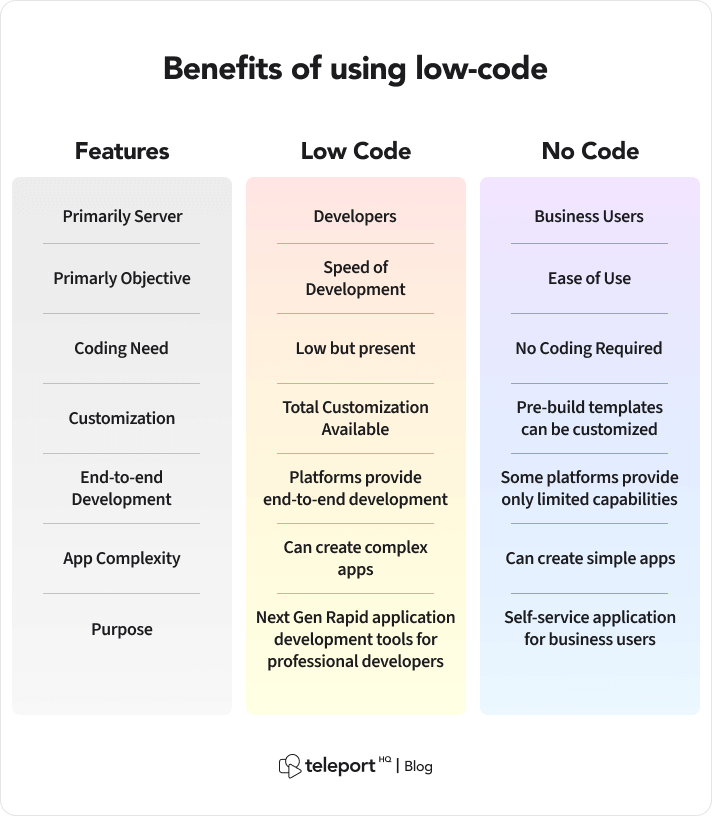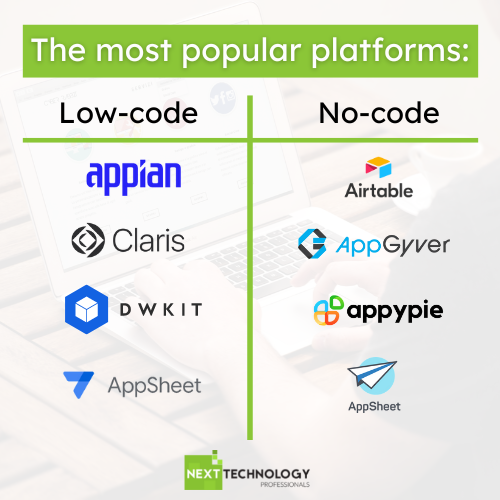Handy Info On Picking Low-Code Platform Info
Handy Info On Picking Low-Code Platform Info
Blog Article
Benefits Of Low-Code Development For Non-Developers In Terms Accessibility
Due to a number of factors, low-code application development is more accessible for non-developers. They are commonly referred to as "citizens developers."
Drag-and-drop Builders: Lowcode platforms have drag-and-drop interfaces that let non-developers create visual applications, without needing codes. This makes development more accessible to people who have no or little technical expertise.
WYSIWYG editors The WYSIWYG editors "What You See is What You get" editors let users build interfaces and workflows that look similar to the final product. This makes it much easier to understand and use.
Simple Logic and Workflow
Visual Workflow modeling: Users can design business processes and application logic using visual flowcharts. These models are simpler to use than traditional codes.
Pre-built Components of Logic Low-code platform often includes pre-built logic (e.g. loops or conditional statements) that can easily be configured, reducing a requirement for complicated programming.
Templates and components that can be reused:
Templates for libraries of pre-built templates Many low code platforms provide a library of the most commonly used kinds of software, giving those who are not developers a base to build upon and then alter.
Reusable Modules and Widgets By using the reuse of modules and widgets users can simplify the design process, while also reducing the requirement for technical knowledge.
Tutorials and guides for development:
Step-by-Step instructions Platforms typically provide on-screen tutorials, guided development paths as well as other tools to assist people who are not developers to create applications.
Interactive Tutorials Interactive tutorials that let you engage with the platform will aid in learning and increase confidence.
Integration with an existing tool:
Easy integration Low-code platforms are created to be able to seamlessly integrate with existing business systems and tools (e.g. ERP, CRM) permitting non-developers to create applications within their current workflows.
APIs connectors and APIs: These devices make integration easier by allowing non-developers (or even end users) to link their applications to external services.
Collaboration Features:
Team Collaboration Features, such as real time collaboration and shared workspaces, enable non-developers and professionals to collaborate efficiently.
Role-based Access Control: You can give non-developers certain roles that have the right access level so that they can be part of the development process while not compromise on security or function.
Automated Testing & Debugging
Built-in Testing Tools: Low-code platforms usually have built-in testing tools and debugging tools to automate these procedures, making it much easier for non-developers to ensure their apps function properly.
Error Highlighting - When problems arise, the platform highlights the issue and offers solutions, guiding users through troubleshooting.
The general rule is that low-code application development can democratize development. This is a major advantage for non-developers. Low-code platforms provide intuitive visual tools, guiding experiences, and let business users actively take part in the creation, maintaining and updating applications. Follow the top rated straight from the source for website info including app modernisation, azure sql databases, application development platforms, software for app development, cross platform app dev, app development platform, cross platform mobile app development, application modernisation, cloud software applications, low code platforms and more.
Low-Code Software Is Cost-Effective.
Low-code app development offers many benefits, including cost efficiency. This is a great alternative for companies looking to maximize their development budgets without compromising on quality. Here are a few of the major benefits:
Lower Coding Requirement: Low Coding platforms remove the need to write code manually, saving developers both time and money. This leads to lower costs of labor.
Reduced Developer Resources: Because low-code is more efficient and less time to develop, less specialized developers will be needed. Hiring and staffing costs can be significantly reduced.
Speedier Time to Market
Accelerated Cycle of Development: Low-code platform visual tools and components allow for rapid application creation, which lets businesses launch their new products quicker. This will result in faster revenue generation and better competitive positioning.
Rapid Prototyping. Businesses can quickly test and create prototypes. This reduces time spent in the development process and allows for rapid iterations built on feedback from users.
Lower cost of maintenance:
The modular architecture and standardized components of apps developed using low-code platforms makes them simpler to maintain. This reduces costs for maintenance and support.
Automated Patches and Updates Low-code platforms can manage patching and updating applications completely. This guarantees that your application remains secure and always up-to-date without requiring a lot of manual effort.
Efficient Resource Utilization:
Contributions from non-developers Low-code platforms permit business users and non-developers alike to be part of the process of development. This democratization enables enterprises to profit from the skillsets of a wide variety of employees.
Improved utilization of IT resources IT departments will be able concentrate on strategic initiatives, instead of getting bogged down by routine tasks of development. This will boost overall productivity and efficiency.
Pricing models that can be scaled:
Subscription Pricing: Many platforms with low-code support flexible pricing models based on subscriptions that can be scaled according to the usage. This allows companies to match their spending to their actual needs and increase their revenue, without incurring large initial cost.
Pay-Asyou-Go Options Certain platforms allow companies to pay for only the amount they spend. This is especially beneficial for small or new businesses that have limited budgets.
Reduction in Third-Party Software Costs:
Built-in Functionalities: Low-code platforms often come with built-in functionalities and integrations that eliminate the requirement for third-party software and tools, leading to savings on licensing fees and subscription fees.
Pre-Built Integrations: The accessibility and pre-built integrations with popular services and system minimizes the requirement for custom development and can save time and money.
Increased ROI
Faster ROI: Businesses can achieve a higher ROI on their apps by combining speedy development, lower costs and speedier times to market.
Increased Agility: Businesses are able to quickly adapt to changes in the market and the needs of customers, ensuring that they stay current and take advantage of new opportunities as they arise.
Train for Less:
User-Friendly Interfaces: The intuitive interfaces and user-friendly features of low-code platforms reduce the learning curve, eliminating the need for extensive training.
Accessible Resources: A lot of platforms that use low-code offer extensive instructional materials, tutorials, and community support. This reduces the need for formal education and costs associated with it.
Streamlined Collaboration:
Enhanced Collaboration Tools : The collaboration tools that are built into the software aid in communication and coordination between the team members. This results in a more efficient project development process and lower overhead.
Unified Development Environment : A unified environment makes work easier and lowers the cost that are associated with managing different platforms and tools.
Low-code development is cost-effective since it reduces development and maintenance expenses. It also reduces the time to market and maximizes resource usage. Pricing models are flexible. These elements combine to provide significant financial benefits for businesses and make low-code development a viable choice for businesses looking to increase their budgets for development while also delivering high-quality, flexible and top-quality applications. Have a look at the recommended Enterprise application development with Low-code Platform url for website examples including ms azure sql, push notifications, push notifications android, developing mobile apps, cross platform mobile development, mobile development platforms, app development platform, ms azure sql, develop cross platform mobile app, develop web application and more.
Benefits Of Low-Code Application Development In Collaboration And Workflow
Low-code development offers many benefits in collaboration and workflow. This makes it a great solution for businesses seeking to boost productivity and simplify the development process. Here are a few advantages.
Unified Development Environment. Low-code platforms allow all team members to collaborate in a single, integrated environment. This includes developers, business analyst designers, stakeholder. They remove silos while encouraging better communication.
Visual Development Tool: The drag-anddrop nature of platforms that use low-code makes it easier for team members who are not technologically inclined to participate in the development process. They can assure that business needs are accurately analyzed and implemented.
Communication Enhancement
Real-Time Collaborative Features: A lot of platforms using low-code have real-time collaborative features, including comments, editing, and immediate feedback. These features facilitate collaboration and cut down in back and forth conversations.
Shared Workspaces : Teams can work together within collaborative workspaces. They are able to view edit, discuss and even discuss components of their project. This makes sure that everyone is working towards a common purpose.
Streamlined Workflow:
Built-in Project Management Tools: Low-code platforms usually contain integrated software for managing projects that help teams organize, track, and organize, and manage their development projects. This includes assigning tasks, tracking progress, and managing deadlines.
Workflow Automation Automating routine tasks or workflows permits teams to concentrate their efforts on more strategic initiatives and tasks and improves the efficiency overall of an organization.
Speedier iteration cycles:
Rapid Prototyping Low-Code platforms are great for speedy prototyping. Iterative development is also possible and allows teams to experiment, create and refine their applications in shorter periods. This allows feedback to be rapidly implemented, and changes can be implemented.
Agile Development Support: Supporting agile methods lets teams and individuals work in smaller increments. This also makes it possible to rapidly adjust to changing circumstances.
Accessibility:
Citizen Development: Low code platforms enable business users (citizens developers) to create and modify applications, without having a deep understanding of programming. This frees IT and Development teams of burdens and allows faster responses to business requirements.
Training and Onboarding. The intuitive interfaces of training tools make it easy for the new members to be familiar with the system, and this helps improve teamwork.
Centralized Knowledge Sharing and Documentation:
Integrated Documentation: Low-code systems usually include features to create and maintain documentation within the platform and ensuring that all project data is easily accessible and centrally located.
Knowledge Repositories. Teams can create and maintain knowledge repositories that include best practices templates and reuseable components, making it easier for knowledge exchange and reducing duplicate effort.
Standardization and consistency:
Standardized Components. The commonality of components across different applications guarantees consistency and helps to make it easier to work and be understood by team members.
Governance and Compliance - Built-in governance frames make sure that the creation of all applications follows organizational standards as well regulatory standards. This reduces non-compliance risk and assures that the applications meet the highest quality standards.
Feedback and Improvement Loops:
Integrated Feedback mechanisms: Low-code platform typically have a built-in feedback mechanism, which allows users to provide feedback on the application. Feedback can then become integrated into the development.
Continuous Improvement: The capacity to quickly test and deploy modifications as a result of feedback ensures constant improvement of software. They are closely aligned to the requirements of users as well as business objectives.
Visualization, Reporting and Analysis:
Real-time Analytics: In-built analytics and reporting provide real time insights into the project's performance, user interaction and development. Data-driven decision-making is possible.
Visual Workflow mapping: Visual tools to map workflows can be utilized by teams to optimize workflows. This helps them identify the bottlenecks, as well as areas of improvement.
The advantages of low-code application development in terms of collaboration and workflow lie in its capacity to unite teams from different backgrounds to streamline communication and also automate processes. This creates a more collaborative and efficient development environment, ultimately leading to higher-quality applications and better alignment with business objectives.